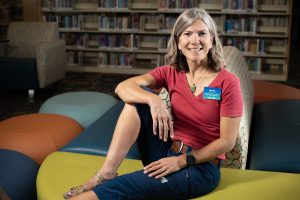This article, by Jen Glass, was originally published in the Arizona Daily Star on August 21, 2023.
“You keep using that word. I do not think it means what you think it means.” Fans of the classic comedy The Princess Bride will recognize this line as Inigo Montoya’s comment to his boss Vizzini.
Although Inigo is referring to Vizzini’s (mis)use of the word “inconceivable,” he could well have been talking about the word “library.” When people hear the word “library,” they often picture a deathly quiet space in which people read silently and a bespectacled librarian shushes anyone who speaks above a whisper. They likely also picture stacks of books, and if they are of a certain age, perhaps a card catalog.
Being a bespectacled person of a certain age myself, I can relate.
Before starting my job at the Martha Cooper Library in 2016, I, too, thought of libraries as quiet places full of, well, books. In my childhood, I was lucky enough to live within walking distance of a Brooklyn Public Library branch in New York City. This branch fit the stereotype quite well back then in the 1970s and 1980s—there were stacks upon stacks of books, old-school card catalogs, heavy wooden desks, and even green library lamps. My neighborhood branch undoubtedly offered far more than access to books, but it looked, smelled, and felt like the quintessential quiet space full of dim lighting and slightly musty, sturdy furniture.
Since I began working for the Pima County Public Library seven years ago, my understanding of “library” has changed dramatically. Yes, our library offers many books as well as quiet spaces in which to read. But the library has become much more. It is a community center, a gathering place, a source of essential resources for those in need.
While working at the Martha Cooper branch as a Library Program Instructor, I witnessed first-hand the multifaceted ways in which the library serves the community. In my main role as a Homework Helper, I assisted K-12 students with math, writing, science, reading, study skills, internet research skills, and communication skills. I even recall helping a high schooler draft a polite email to her teacher about assignments that she had submitted but hadn’t yet received credit for.
I also found myself distributing free snacks to hungry young people, helping ex-offenders apply for jobs that would assist them with rebuilding their lives, participating in highly competitive sessions of “Let’s Dance” on the Nintendo Wii, and singing Brazilian capoeira songs along with special presenters and library patrons. More importantly, I witnessed my caring, empathetic, and quirky colleagues as they forged positive relationships with the many kids, teens, and adults who came in to our branch. Soon enough, I, too, was developing those connections.
Was our branch always a haven for those eager to read in silence? Not exactly. Was it full of musty furniture and green desk lamps? Not at all. It was light, modern, lively, sometimes loud, and full of young people doing everything from reading to dogs to playing Jenga.
The ongoing renovations to the Martha Cooper branch will create more space for everyone and allow for more truly quiet nooks in which to read as well as more space for kids and teens to enjoy a safe space in which to learn but also play. But the reality is that all library branches within the Pima County system serve as much more than quiet spaces full of books. Even in terms of online offerings, the library offers incredibly helpful information and tools.
So what does the word “library” really mean? To me, it means energy, life, learning, community. It means opportunity. It means access. Where else can any member of the public find information, food, job help, computer help, homework help, arts and crafts programs, and more—all for free? Maybe what “library” truly means is the most democratic institution in our democracy.
In addition to working as a Library Program Instructor at Pima County Public Library, Jen Glass works as a Writing Specialist at the Writing Skills Improvement Program at the University of Arizona. Before joining Pima County Public Library and the UA, Jen taught high school at University High School for almost nine years. She also has experience teaching English to speakers of other languages in the U.S. and abroad. In her spare time, she enjoys cycling and Zumba.


